历史
Beginnings
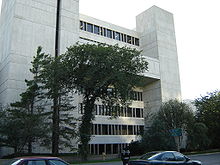
The eastern façade of the Academic Health Sciences Building prior to the construction of the E-Wing.
The institution was modelled on the American state university, with an emphasis on extension work and applied research. The University was created on April 3, 1907 by a provincial statute known as the University Act. It provided for a publicly funded, yet independent institution to be created for the citizens of the whole province.
The governance was modelled on the provincial University of Toronto Act of 1906 which established a bicameral system of university government consisting of a senate (faculty), responsible for academic policy, and a board of governors (citizens) exercising exclusive control over financial policy and having formal authority in all other matters. The president, appointed by the board, was to provide a link between the two bodies and to perform institutional leadership. The scope of the new institution was to include colleges of arts and science, including art, music and commerce, agriculture with forestry, domestic science, education, engineering, law, medicine, pharmacy, veterinary science and dentistry.
It awarded its first degrees in 1912. In the early part of this century, professional education expanded beyond the traditional fields of theology, law and medicine. Graduate training based on the German-inspired American model of specialized course work and the completion of a research thesis was introduced.
Battleford, Moose Jaw, Prince Albert, Regina, and Saskatoon all lobbied to be the location of the new university. Walter Murray preferred the provincial capital, Regina. In a politically influenced vote, Saskatoon was chosen on April 7, 1909.
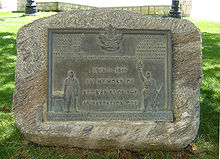
Plaque commemorating World War I veterans: "1914–1918 In Memory of All Ranks of the 46th Battalion C.E.F. They are too near to be great, but our children shall understand when and how our fate was changed, and by whose hand."
校园
National Historic Site located on the Main campus of the University of Saskatchewan
A location next to the South Saskatchewan River, across from the city centre of Saskatoon, was selected for the campus. The Prime Minister of Canada, Sir Wilfrid Laurier, laid the cornerstone of the first building, the College Building, on July 29, 1910. Brown and Vallance were the initial architects constructing the first university buildings in Collegiate Gothic style. The original buildings were built using native limestone – greystone – which was mined just north of campus. Over the years, the greystone was to become one of the most recognizable campus signatures. When the local supply of limestone was exhausted, the University turned to Tyndall Stone, so called because it is quarried at Tyndall, Manitoba. The first building to be started on the new campus, the College Building, built 1910- 1912 opened in 1913; in 2001, it was declared a National Historic Site of Canada The Old Stone School, built in 1887, was declared a National Historic Site of Canada
Saskatchewan's Provincial University and Agricultural College were officially opened May 1, 1913 by Hon. Walter Scott.
The original architectural plan called for the university buildings to be constructed around a green space known as the bowl. Currently, the original university buildings are being connected by skywalks and tunnels. Clockwise, from the north; Thorvaldson Building (August 22, 1924) (Spinks addition); Geology, W.P. Thompson Biology (1960) adjoined to Physics Building (1921); College Building (May 1, 1913) (Administration addition); Saskatchewan cojoined with Athabasca Hall (1964); Qu'Appelle Hall (1916); Marquis Hall adjoined to Place Riel – Qu'Appelle Addition; Murray Memorial Main Library (1956); Arts (1960) cojoined with Law and adjoined to Commerce building complete the initial circle around the perimeter of the bowl.
Establishment of Colleges
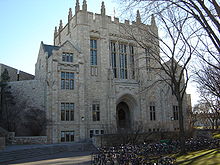
Entrance to Thorvaldson Building located on the Main campus of the University of Saskatchewan
Main article: University of Saskatchewan Academics
Roughly adhering to the original plan of 1909, numerous colleges were established: Arts & Science (1909), Agriculture now called Agriculture and Bioresource (1912), Engineering (1912), Law (1913), Pharmacy now called Pharmacy & Nutrition (1914), Commerce now the N. Murray Edwards School of Business (1917), Medicine (1926), Education (1927), Home Economics (1928), Nursing (1938), Graduate Studies and Research (1946), Physical Education now called Kinesiology (1958), Veterinary Medicine (1964), Dentistry(1965), and School of Physical Therapy (1976).
The U of S also has several graduate programs amongst these colleges, which give rise to a masters or doctorate degree. In 1966, the University of Saskatchewan introduced a masters program in adult education. Diploma, and certificate post secondary courses are also available to aid in professional development.
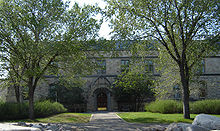
Entrance to the Field Husbandry > Crop Science > Anthropology & Archaeology Building located on the Main campus of the University of Saskatchewan
Theological Colleges, affiliated with the university, were also established: Emmanuel College – (Anglican denomination) (1909), St. Andrew's College (as Presbyterian College, Saskatoon) then United Church of Canada (1913), Lutheran Theological Seminary (1920), St. Thomas More College (1936), and Central Pentecostal College (1983).
Regina College was saved from bankruptcy and became part of the university in 1934, and was given degree-granting privileges in 1959, making it a second University of Saskatchewan campus. By another act of legislation in 1974, Regina College was made an independent institution known as the University of Regina.
The policy of university education initiated in the 1960s responded to population pressure and the belief that higher education was a key to social justice and economic productivity for individuals and for society. The single-university policy in the West was changed as existing colleges of the provincial universities gained autonomy as universities.
Correspondence courses were established in 1929.
Other federated and affiliated colleges include Briercrest Bible College and Biblical Seminary in Caronport, Saskatchewan; Gabriel Dumont College and St. Peter's Historic Junior College in Muenster, Saskatchewan.
Later development
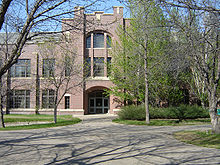
Entrance to the Engineering Building located on the Main campus of the University of Saskatchewan
In the late 1990s, the U of S launched a major revitalisation program, comprising new capital projects such as an expansion to the Western College of Veterinary Medicine, the building of a new parkade, and a revision of its internal road layout (which has already seen the East Road access being realigned). The Thorvaldson Building, which currently is home to the departments of chemistry and computer science, hosts a new expansion known as the Spinks addition. The College of Pharmacy and Nutrition has also seen a number of renovations.
Land holdings
Up until the late 1980s, the University of Saskatchewan held an extensive area of land in the northeast quadrant of Saskatoon, stretching far beyond the core campus, east of Preston Avenue and north of the Sutherland and Forest Grove subdivisions. Much of this land was used for farming, though some areas were intended for future campus and facility development. In the late 1980s, most U of S land beyond Circle Drive was earmarked for residential development; Silverspring was the first of these neighbourhoods to be developed.

The Bowl located on the Main campus of the University of Saskatchewan
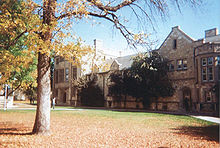
Saskatchewan Hall is a student residence
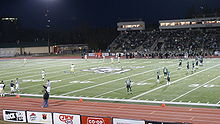
U of Saskatchewan Huskies football
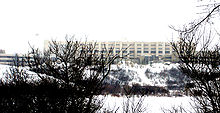
Royal University Hospital (1955 Wing)
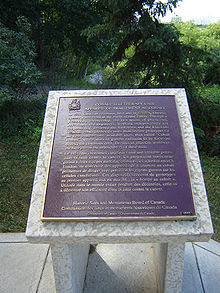
U of S Cobalt Therapy Unit
Another section of land, west of the Preston Avenue/Circle Drive interchange and north of the CPR line, was zoned for commercial use, and led to "big box" retail development in the early 2000s called Preston Crossing). Realignment of two major roads in the area around this same time (Preston Avenue and 108th Street) also used up a portion of university land. The U of S now maintains a large tract of land immediately east of the Saskatoon city limits that it obtained after the city annexed the northeastern section of U of S land. The U of S leased a site to the Correctional Service of Canada north of Attridge Drive on Central Avenue for the Regional Psychiatric Centre. It has an additional undeveloped parcel of land at Central Avenue and Fedoruk Drive.
In the 1970s and again in the 1980s, the U of S considered opening up some of its land holdings south of College Drive and north of 14th Street for residential development, but opposition from nearby neighbourhoods that appreciated the "green belt" offered by the university led to these plans being dropped.
Programs
Main article: University of Saskatchewan Academics
Classes and programs are offered in Agriculture and Bioresources, Arts and Science, , Biotechnology, Business, Dentistry, Education, Engineering, Graduate Studies and Research, Kinesiology, Law, Medicine, Nursing, Pharmacy and Nutrition, Physical Therapy and Veterinary Medicine. Various classes and programs are also offered through colleges affiliated with the University of Saskatchewan. Some of these are Briercrest College, Central Pentecostal College, College of Emmanuel and St. Chad, Emma Lake Kenderdine Campus, Gabriel Dumont Institute of Métis Studies and Applied Research, Horizon College and Seminary, Lutheran Theological Seminary, Open Studies, Saskatoon Theological Union, St. Andrew's College, St. Peter's College, St. Thomas More College, Virtual College of Biotechnology, and Centre for Continuing and Distance Education/Extension Division.
Students and Alumni
Main article: List of University of Saskatchewan alumni
The University Act provided that the University should provide "facilities for higher education in all its branches and enabling all persons without regard to race, creed or religion to take the fullest advantage". It further stated that "no woman shall by reason of her sex be deprived of any advantage or privilege accorded to the male students of the university." Seventy students began the first classes on September 28, 1909. The first class graduated on May 1, 1912. Of the three students who earned graduation honours, two were women.
342 students, faculty, and staff enlisted for World War I. Of these, 67 were killed, 100 were wounded, and 33 were awarded medals of valour.
Between 1907 and 2007 there have been over 132,200 members of the University of Saskatchewan Alumni Association. The alumni feature those who have successfully graduated from a degree, certificate and/or diploma programme at the University of Saskatchewan.
Notable faculty and researchers
- The Honourable Gordon L. Barnhart, University Secretary, Professor in Canadian Politics, and Lieutenant-Governor of Saskatchewan (2006–)
- The Honourable Sylvia O. Fedoruk, University Chancellor, Professor in Oncology, Associate Member in Physics, and Lieutenant-Governor of Saskatchewan (1988–1994).
- The Honourable J.W. Grant MacEwan, Director of the School of Agriculture, Professor of Animal Husbandry, and Lieutenant-Governor of Alberta (1966–1974).
- Gerhard Herzberg, Nobel Prize in Chemistry, 1970 – Offered a position in 1935 to flee Nazi Germany, and remained at the university for ten years.
- William Sarjeant, geologist and novelist.
- Dr. Thorbergur Thorvaldson, internationally known scientist and first dean of graduate studies at the U of S.
- Dr. Hilda Neatby (1904–1975), historian.
- Dr. Herbert V. Guenther (1917–2006), Buddhist scholar and philosopher.
Notable alumni
- Emmett Matthew Hall, (1898-1995), O.C., C.C., Q.C., LLB, Supreme Court judge and a father of the Canadian system of Medicare
- The Right Honourable Raymon Hnatyshyn, 24th Governor General of Canada
- The Honourable Dr. Lynda M. Haverstock, Lieutenant-Governor of Saskatchewan (2000–2006), Leader of the Saskatchewan Liberal Party (1989–1995)
- The Honourable Fredrick W. Johnson, 16th Lieutenant-Governor of Saskatchewan
- The Honourable George Porteous, 14th Lieutenant Governor of Saskatchewan
- The Right Honourable John G. Diefenbaker, 13th Prime Minister of Canada
- Diefenbaker was also the university's chancellor. After he died, he and his wife were buried at the university, near the Diefenbaker Canada Centre.
- The Honourable Jonathan Denis, Alberta MLA and Minister of Housing and Urban Affairs (LLB, 2000)
- Henry Taube, Nobel Prize in Chemistry 1983
- Dr. John Hewson, Australian politician
- Tommy Douglas, former leader of the New Democratic Party and leader of health care reform in Canada (also voted "the Greatest Canadian" of all time in 2004)
- Alastair GW Cameron Astrophysicist. Famed for his theories on the origin of the chemical elements and the origin of the moon.
- N. Murray Edwards - business owner
- W. Brett Wilson - entrepreneur, philanthropist, author, speaker and a star of CBC's hit Dragons' Den
- Edith Fowke Canadian folklorist.
- Lorne Babiuk - Scientist
- Dr. Michael Byers (Canadian author) - celebrity political scientist at the University of British Columbia and federal NDP candidate in the Vancouver Centre riding
- Guy Vanderhaeghe, (1951- ), novelist, winner of the Governor General's Award, and officer of the Order of Canada.
- Dr. Hilda Neatby (1904–1975), historian.
- Kim Coates, actor.
- Dr. Gordon Thiessen, former Governor of the Bank of Canada.
- Dr. Goh Thong Ngee, Professor at the National University of Singapore, recipient of the William G. Hunter Award (2007)
Rhodes Scholars
- Mark Abley 1975
- Dwight Newman 2005
Distinguished research
Over the years, some of the most prominent projects at the University have been associated with the Department of Physics. In 1948, the university built the first betatron facility in Canada. Three years later, the world's first non-commercial cobalt-60 therapy unit was constructed. (The first female Chancellor of the University, Sylvia Fedoruk, was a member of the Cobalt-60 research team. She also served as Saskatchewan's Lieutenant-Governor from 1988–1994.) The success of these facilities led to the construction of a linear accelerator as part of the Saskatchewan Accelerator Laboratory in 1964 and placed university scientists at the forefront of nuclear physics in Canada. Experience gained from years of research and collaboration with global researchers led to the University of Saskatchewan being selected as the site of Canada's national facility for synchrotron light research, the Canadian Light Source. This facility opened October 22, 2004 and is the size of a football field. The Plasma Physics Laboratory operates a tokamak on campus. The University used the SCR-270 radar in 1949 to image the Aurora for the first time.
The university owns the Vaccine and Infectious Disease Organization. Innovation Place Research Park is an industrial science and technology park that hosts private industry working with the university.
Royal connections
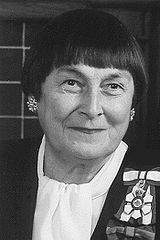
Lieutenant Governor Sylvia Fedoruk was Chancellor of the University of Saskatchewan in Saskatoon from 1986-1989.
Further information: Crown in Saskatoon
The University of Saskatchewan has numerous royal and vice-regal connections. Lieutenant Governor Archibald McNab is credited with bringing the institution to Saskatoon. Its campuses have been venues for royal and vice-regal visits, including visits by the Queen and the Duke of Edinburgh, who lodged at the President's Residence in 1978. A handful of University alumni were invited to a reception for Canadians at Buckingham Palace ahead of that visit to Saskatoon. The main campus is home to Saskatoon's only royally designated institution, the Royal University Hospital. The Diefenbaker Canada Centre, also on campus, houses original correspondence between the Queen and Prime Minister John Diefenbaker, and has staged such exhibits as Happy and Glorious: The Royal Presence in Canada, opened by Lieutenant Governor Lynda Haverstock in 2004. The campus was the first in Western Canada to host the Vanier Cup, named for Governor General Georges Vanier, in 2006. Fifteen fellows of the Royal Society of Canada are affiliated with the University of Saskatchewan.
Saskatchewan's Lieutenant Governors have filled the office of Visitor to the University of Saskatchewan since its establishment. Former Lieutenant Governor Sir Richard Lake was famously called upon to assume the visitor's role in the so-called Crisis of 1919. Four senior members of the Board of Governors had been dismissed after three among them abstained from a vote of confidence in university president Walter Murray. Murray was under scrutiny for his maintenance of University finances. The public and press clamoured for an explanation, and, in accordance with provincial law, Lake held a series of hearings through the office of the King’s Bench. His findings, delivered in April 1920, vindicated the dismissals, saying they were “regular, proper and in the best interest of the university.” In other words, their acts of disloyalty were enough to cost them their jobs.
Certain vice-regal representatives have held teaching and governance positions on campus. Before becoming Lieutenant Governor, Gordon Barnhart was university secretary and professor in Canadian politics. Sylvia Fedoruk was university chancellor, professor in oncology and associate member in physics. Grant MacEwan, before becoming Lieutenant Governor of Alberta, was director of the School of Agriculture and professor of animal husbandry at the University of Saskatchewan. Honorary Doctor of Laws degrees have been conferred by the university on vice-regal representatives. Recipient Lieutenant Governors include William Patterson in 1955, Robert Hanbidge in 1968, Stephen Worobetz in 1984 and Sylvia Fedoruk in 2006. Recipient Governors General include Vincent Massey in 1955 and Ramon Hnatyshyn in 1990.
University administration
There are three separate areas of governance at the University of Saskatchewan. Financial, management, as well as administration affairs are handled by the Board of Governors, which comprises 11 members. The University of Saskatchewan liaison between the public and professional sector is dealt with by the university Senate, a body of 100 representatives. Finally, the General Academic Assembly is the university's advisory body wherein, all the faculty members and elected students combine to determine academic policies and direction. In 1995, the General Academic Assembly is represented by elected members to the University of Saskatchewan Council which is made up of a combination of 116 faculty and students. As of 2006, faculty and staff total 7,000, and student enrolment comprised 15,005 full time students as well as 3,552 part time students.
In October 2008, the University of Saskatchewan was named one of Saskatchewan's Top Employers, which was announced by the Saskatoon StarPhoenix and Regina Leader-Post newspapers.
The Board of Governors administrators comprise Chancellor W. Tom Molloy, O.C., Q.C., B.A., LL.B, President and Vice-Chancellor Dr. R. Peter MacKinnon Q.C., B.A., LL.B, LL.M., LL.D.; Vice-Presidents or Resource Officers: Dr. Michael Atkinson, Provost and Vice-President Academic; Richard Florizone, Vice-President (Finance & Resources); Dr. Steven Franklin, Vice-President (Research); Heather Magotiaux, Vice-President (University Advancement).
University Presidents
The past 100 years have seen eight university presidents beginning with Walter Charles Murray (1908–37) who helped establish and set the groundwork for the University of Saskatchewan. In other words,
to make a University where no University existed.
James Sutherland Thomson (1937–49) was the second president
during some of the most difficult years in the institution's history. His term spanned the final years of the Great Depression, the Second World War, and the hectic, early post-war years.
Walter Palmer Thompson persidency term (1949–59) spanned the university's 50th anniversary year. Dr. Walter Murray said to him
"Do not be appalled at the absence of all you have been accustomed to find in other Universities. We have all had to start with nothing.. .You have virgin soil to break."
In many fields Biologist Walter P. Thompson leadership brought innovation, insight and research to new areas beginning with rust resistant varieties of wheat which curtailed the 1916 catastrophic outbreak of rust. He also was instrumental in developing in Saskatchewan a comprehensive medicare program. His popularity and qualities of administrator and teacher served the U of S well during his presidency. The fourth and youngest Canadian university president, John William Tranter Spinks (1959–74) brought in a whirlwind era for the university.
...enrolment sky rocketed, a new campus was opened, new buildings were erected, new colleges and schools were started and course offerings were increased. This included a comprehensive health care complex, establishment of a Crop Development Centre, a Linear Accelerator Laboratory, SED Systems, an Institute for Northern Studies, and an Indian and Northern Education Program.
Robert William Begg (1974–80) became the fifth U of S president, who received the Order of Canada during his term in office
for his distinguished career in education and for his contributions to cancer research.
The next president was Leo Friman Kristjanson (1980–89) who served a foreshortened term due to the onset of Parkinson's disease. However, even during this tenure from which he left early, the University saw the addition of the Innovation Place research park, Geology Building, Kinsmen Children's Centre, The Centre for the Study of Co-operatives, a new Saskatoon Cancer Clinic, expansion of health science facilities, the Rt. Hon. John G. Diefenbaker Centre, and the groundwork was laid for the new agriculture building. The sixth university president was J.W. George Ivany (1989–99).
The J.W. George Ivany Internationalization Award, to be presented annually, was established in 1998 to acknowledge Dr. Ivany's "commitment to internationalization and his leadership in fulfillment of that commitment".
The current president ushering forward the University of Saskatchewan's centennial year is R. Peter MacKinnon (1999– ).
University Chancellors
The University of Saskatchewan chancellor would have the duties to preside over convocation ceremonies whereupon they would confer degrees, they chair the Senate and become members of the Board of Governors.
The first University of Saskatchewan chancellor was Justice Edward Ludlow Wetmore B.A. (1909–1917). The University of Saskatchewan Board of Governors honoured him with an honorary D.C.L., in recognition of the contributions Edward Wetmore gave to
both (the province and country) [which] enjoy in rich measure the results of his great common sense, his judiciousness and his high sense of public duty in shaping those fundamental traditions which give character and direction to the activities of two of the most influential institutions of the State, the judiciary and the University.
Honourable Sir Frederick W. A. G. Haultain K.B., the second chancellor served the university 1917–1940. Sir Frederick W. A. G. Haultain, Chief Justice of Saskatchewan, was instrumental in the establishment of the provinces of Saskatchewan and Alberta from the North West Territories, also Commissioner of Education, he also spent time and energy developing the early school system on the rugged frontier. Next, in line was Justice P. E. MacKenzie B.A. and LL.B. between 1940–1946. In the years 1946–1947 Donald Maclean BSc, LL.B and was a valued contributor to the University of Saskatchewan, and was awarded an honorary bachelor of law as well as appointed fourth chancellor. F. H. Auld LL.D., OBE became the University's fifth chancellor holding several three year terms between 1947–1965. Francis Hedley received great recognition as Deputy Minister of Agriculture in Saskatchewan for his improvements. E.M. Culliton CC, S.O.M., Q.C., D.C.L., served the university as chancellor from 1965 to 1969. He served Saskatchewan in many fields and was regarded as the
cornerstone of a sound Saskatchewan judiciary.
John Diefenbaker CH, PC, QC, FRSC, FRSA became the seventh chancellor between 1969–1979. He served country as Prime Minister and province as Member of Parliament well, and strived toward the
ultimate balance for free enterprise, profit-making and economic growth on the one hand, and social justice and respect for the interests of the common man on the other."
Emmett M. Hall CC, QC, LL.B, LL.D served as next chancellor for two terms between 1979–1986. Emmett M. Hall was chairman of several committees that helped to shape Saskatchewan. Saskatchewan's public health insurance was the precursor for Canada's national medicare system, as well as reforms to the current issues involving education, court structure and grain handling. Sylvia O. Fedoruk OC, SOM followed as ninth University Chancellor from 1986–1989. Sylvia Fedoruk is renowned as a famous physics scientist who was implemental in developing the world’s first Cobalt 60 unit and first nuclear medicine scanning machines. Sylvia also was a renowned curler, and Lieutenant Governor of Saskatchewan and contributed to Saskatchewan's growth in many areas. Between 1989–1995, E. K. Turner, C.M., LL.D., S.O.M. served as the University of Saskatchewan's ambassador, becoming the university's tenth chancellor. Saskatchewan agriculture benefited from the life work of E. K. Turner both internationally and nationally. Peggy McKercher C.M., SOM, B.A., LL.D. elected by acclamation served as university chancellor between 1995–2001. Peggy McKercher has been always involved in civic growth and development. She has been honoured and gain tremendous recognition for her involvement in the fields of heritage, culture, and municipal development. W. Thomas Molloy OC, QC served between 2001–2007. He received the Order of Canada for
his integrity, commitment to a just settlement and personable rapport.
On July 1, 2007, Dr. Vera Pezer BA, MA PhD. was elected thirteenth chancellor of the University of Saskatchewan. Vera Pezer has served the university for a number of years as student counsellor, faculty member and dean. She has achieved success as a champion curler, author, and member of several civic steering committees.
Partner universities
- University of Greifswald, Greifswald, Germany
- Darmstadt University of Technology, Darmstadt, Germany
- Vellore Institute of Technology,India
Notable companies started by alumni and spin-offs
- SED Systems
- IL Therapeutics
- Quack.com by Steven Woods B.Sc. '87 and Verna Friesen B.Sc. '87 (acquired by America Online)
- See also On Campus Adjunct Research Facilities
Museums and galleries
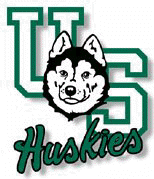
University of Saskatchewan Huskies
Agricultural Displays and Kloppenburg Collection are hosted in the Agriculture & Bioresources College. The agricultural wall displays are located in the walkway connecting the Agriculture Building and the Biology Building. The Kloppenburg Collection is featured on the sixth floor of the College of Agriculture and Bioresources building which opened in 1991. Twenty seven works by famous Saskatchewan artists are featured in this donation to the University of Saskatchewan. Beamish Conservatory and Leo Kristjanson Atrium is also located within the Agriculture & Bioresources College. The Leo Kristjanson atrium is located in the College of Agriculture and Bioresources building and hosts the conservatory. The Beamish Conservatory is named in honour of the donor May Beamish who is the daughter of artist Augustus Kenderdine.
The University of Saskatchewan's 75th Anniversary in 1984 was the starting catalyst for the Athletic Wall of Fame at which time 75 honours were bestowed. The wall of fame celebrates achievements by athletes, teams securing a regional and/or national championship, as well as builders who can be either an administrator, coach, manager, trainer or other major contributor toward the Huskie athletic community for a time period of at least 10 years and have provided outstanding notable support. As of 2001, an annual event, the Huskie Salute inaugurates a new candidate into the Athletic Wall of Fame.
The College Building was officially declared a Canadian National Historic Site by Sheila Copps, Minister of Canadian Heritage on February 27, 2001. The College building was the first building under construction on the University, and upon completion was used for agriculture degree classes.
The Right Honourable John G. Diefenbaker Centre for the Study of Canada or The Diefenbaker Canada Centre houses the Diefenbaker paper collection and legacy, changing exhibit, Centre for the Study of Co-operatives and the Native Law Centre. The grave site of Canadian Prime Minister John Diefenbaker is located near this museum.
The Gordon Snelgrove Gallery features displays of Master of Fine Arts graduating exhibitions, as well as Bachelor of Fine Arts shows, and is located within the Murray Building on campus.
Kenderdine Art Gallery celebrated its official opening October 25, 1991. Augustus Frederick Lafosse (Gus) Kenderdine began the University Art Camp at Emma Lake in 1936, the precursor to the Emma Lake Kenderdine Campus, a bequest was donated to the University of Saskatchewan by his daughter, Mrs. May Beamish, and initialized the formation of the Kenderdine Art Gallery which has a permanent collection started by Dr. Murray, as well as ongoing exhibits.
MacAulay Pharmaceutical Collection is located in the Thorvaldson Building, Room 118A. The collection showcases turn of the century pharmaceutical paraphernalia as well as early remedies such as cherry bark syrup and smartweed. Memorial Gates were constructed in honour of those U of S students who made the ultimate sacrifice. Inscribed on the gates themselves is an inscription, “These are they who went forth from this University to the Great War and gave their lives that we might live in freedom.”
The Museum of Antiquities started its collection in 1974, and opened in 1981 at its new location. The museum celebrates notable artistic, sculptural and art achievements of various civilisations and eras.
W. P. Thompson Biology Building hosts a two story high atrium which houses both geological and biological displays as well as a full-size skeleton of a Tyrannosaurus Rex.
The University of Saskatchewan Observatory offers public viewing hours, school tours, as well as an adopt-a-star program. An adopted star can commemorate a special or significant achievement, or person and the award is given via certificate, honourable registry mention and maps of star location and facts sheet.
Rugby Chapel, moved from Prince Albert, built in 1912, has been declared a City of Saskatoon Municipal Heritage Property. Rugby Chapel, the precursor to College of Emmanuel and St. Chad was first constructed in 1883 and designated the The University of Saskatchewan (Saskatchewan Provisional District of the North West Territories), in Prince Albert.
St. Thomas More College Art Gallery was first opened in 1964 and hosts artwork of local and regional artists.
Victoria School House (Little Stone School House) built 1888 as the first school house of the Temperance Colony. The one room school house was originally constructed in Nutana. The location is now known as five corners at the south or top of the Broadway Bridge. The school yard at one time comprised three school houses, as the population grew. The little stone school house was preserved and moved on campus. It was declared a historic site June 1, 1967.
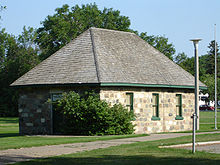
Victoria One Room Schoolhouse
Campus life
The Sheaf, a student publication, was first published in 1912, monthly or less frequently. By 1920, it was published weekly with the aim of becoming a more unifying influence on student life. It has continued to publish.
In 1965, a student-run campus radio station, CJUS-FM began broadcasting on a non-commercial basis. In 1983, the station became a limited commercial station. By 1985, however, funding was no longer provided, and the campus radio presence died. In early 2005, CJUS was revived in an internet radio form and continues to broadcast today. The university also maintains a relationship with the independent community radio station CFCR-FM, which actively solicits volunteers on campus.
Place Riel Theatre, a campus theatre, was opened in 1975, as was Louis, a campus pub. Place Riel, the existing campus student centre, opened in 1980, and now holds retail outlets, arcade, lounge space, student group meeting areas, and a food court; it is presently undergoing expansion and renovation, slated for completion in 2012-2013. These facilities were named after Louis Riel. In the late 1990s, Place Riel Theatre stopped public showings and it is now used for campus movie features and lectures.
The University of Saskatchewan has adopted as its logo the book of knowledge and three wheat sheaves set inside of a green heraldic shield. The wheat sheaves and book of knowledge are yellow. Upon the pages of the book of knowledge is the Latin phrase Deo et Patrie which when translated means For God and Country.
The official motto of the university is Deo et Patriae (Latin) which translates to God and Country.
Campus sports teams in Canadian Interuniversity Sport use the name Saskatchewan Huskies. The U of S Huskies presently compete in eight men's sports: Canadian football, basketball, cross country, hockey, soccer, track and field, volleyball and wrestling and seven women's sports: basketball, cross country, hockey, soccer, track and field, volleyball and wrestling. The men's Huskyfootball team has won the Vanier Cup as national champions on three occasions; in 1990, 1996, and 1998.
Song
Notable among a number of songs commonly played and sung at various events such as commencement and convocation, and athletic games are: Fight, the University of Saskatchewan fight song, which was composed by Russell Hopkins: "Fight, fight, fight for the dear old Green and White, Saskatchewan, our University. And it’s shout, shout, shout and let your voice ring out, For Saskatchewan, our University. We’ll rise to a man, be it win or lose or draw, And cheer old Alma Mater with a rah-rah-rah! For Deo Patrie our mother strong and free- Saskatchewan our University - Rah!"
Residence life
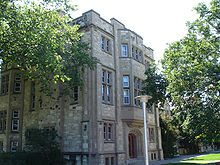
Saskatchewan Hall residence building
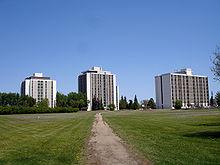
McEwon Park residence towers
- Voyageur Place Room and board residences on the University of Saskatchewan campus and comprises four separate halls.
- Saskatchewan Hall was the first student residence of the university and was completed in 1912. Originally called University Hall, it was designed to provide residences for 150 students. Saskatchewan Hall was named for the Saskatchewan River.
- Qu'Appelle Hall was originally known as Student’s Residence No. 2 and officially opened in 1916. The design housed 120 students, and in 1963 an addition for 60 additional student residences was completed. The Qu'Appelle Hall Addition is the fourth residence of Voyageur Place and houses male students. Qu'Appelle Hall was named for the Qu'Appelle River.
- Athabasca Hall provides 270 residences and was completed in 1964. It is now a co-ed hall. Athabasca Hall was named for the Athabasca River.
Voyageur Place has historically been organized on the house system, with each house named after an explorer associated with Saskatchewan's early history. Thus, traditionally there were three male houses: Hearne House (named after Samuel Hearne and consisting of the residents of Saskatchewan Hall); Kelsey (named after Henry Kelsey and consisting of the residents of Qu'Appelle Hall); and Lav (named after Pierre Gaultier de Varennes, sieur de La Vérendrye and consisting of the residents of Qu'Appelle Hall Addition). There were also three female houses (all of which were composed of residents of the all-female Athabasca Hall): Pond (named after Peter Pond), Henday (named after Anthony Henday), and Palliser (named after John Palliser).
- McEown Park – Residence complex south of the university campus. Opening ceremonies were October 2, 1970 for the four high rise complex. McEown Park was named in honour of a University administrator, A.C. McEown.
- Souris Hall is an apartment complex for married students with families. Souris Hall, named after the Souris River, is a nine-storey town house, comprising 67 two-bedroom apartments.
- Assiniboine Hall is an eleven-storey apartment house which has 23 two-bedroom and 84 one-bedroom apartments available for married or single students without families. Assiniboine Hall was named for the Assiniboine River.
- Wollaston Hall was added to McEown Park complex in 1976, providing 21 two-bedroom and 83 one-bedroom apartments.
- Seager Wheeler Hall provides housing for single students living in small groups in a fourteen-storey residential house. Seager Wheeler Hall was named in honour of Seager Wheeler, a notable Saskatchewan pioneer for breeding wheat. This residence was on the original three complexes built at McEown Park.
On February 6, 2009, the provincial government announced $15 million of funding toward the construction of additional residence buildings adjacent to the existing McEwon Park development. The project, headed by Saskatoon-based Meridian Development Corporation, is scheduled to begin in late 2009 with full occupancy anticipated for 2011.
Aboriginal
The University of Saskatchewan provides services to Aboriginal people in more remote communities. The University of Saskatchewan Summer University Transition Course brings first-year Aboriginal students to campus before the start of the school year for some campus orientation. Academic counsellors, tutors and Aboriginal elders are present on campus at the University of Saskatchewan to provide academic and social supports. To assist with the transition to a fulfilling career, the University of Saskatchewan is participating in an Aboriginal Lynx Career and Employment Project led by University of Calgary.
更多
 |
Wikinews has related news: Canada pursues new nuclear research reactor to produce medical isotopes |
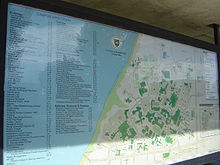
Map of the Campus area – University of Saskatchewan
- Griffiths Stadium
- Higher education in Saskatchewan
- List of agricultural universities and colleges
- List of colleges and universities in Saskatchewan
- Memorial Gates (University of Saskatchewan)
- University of Saskatchewan Huskies
- University of Saskatchewan Academics
- University of Saskatchewan Students' Union
Histories of the University
- Michael Hayden 'Seeking a Balance: The University of Saskatchewan, 1907-1982' (Vancouver: University of British Columbia Press, 1982)
- Michael Hayden. "The Fight that Underhill Missed: Government and Academic Freedom at the University of Saskatchewan, 1919-1920." In Academic Freedom: Harry Crowe Memorial Lectures 1986, edited by Michiel Horn. North York: York University, 1987.
- Shirley Spafford 'No Ordinary Academics: Economics and Political Science at the University of Saskatchewan,1910-1960' (Toronto: University of Toronto Press, July 1, 2000)
参考文献
- ^ Enrolment Report: Census Day • October 08, 2009
- ^ "University of Saskatchewan Act" (pdf). Government of Saskatchewan. http://www.qp.gov.sk.ca/documents/English/Statutes/Statutes/U6-1.pdf. Retrieved 2009-07-11.
- ^ "Deo et Patriae: Events in the History of the University of Saskatchewan: 1907". University of Saskatchewan. http://scaa.usask.ca/gallery/uofs_events/articles/1907.php. Retrieved 2007-06-24.
- ^ "U of S: History". University of Saskatchewan. http://explore.usask.ca/about/history/. Retrieved 2007-06-24.
- ^ B. Beaton. "University of Saskatchewan". The Canadian Encyclopedia. http://thecanadianencyclopedia.com/index.cfm?PgNm=TCE&Params=A1ARTA0008258. Retrieved 2007-06-24.
- ^ Don Kerr (1998). "The Beginnings". http://scaa.usask.ca/gallery/uofs_buildings/history_text1.htm. Retrieved 2007-06-24.
- ^ B. Beaton. "University of Saskatchewan". The Canadian Encyclopedia. http://thecanadianencyclopedia.com/index.cfm?PgNm=TCE&Params=A1ARTA0008258. Retrieved 2007-06-24.
- ^ "Life Long Learning in Pharmacy – 6th International Conference". 2005. http://www.lllp.usask.ca/vtt/index.php. Retrieved 2007-06-24.
- ^ MacPherson, Colleen (2007-03-09). "On Campus News (OCN) – University of Saskatchewan". http://www.usask.ca/communications/ocn/07-mar-09/10.php. Retrieved 2007-06-24.
- ^ Eggertson, Laura. "Innovation Canada – Vaccine Nation". http://www.innovationcanada.ca/10/en/articles/article1.html. Retrieved 2007-06-24.
- ^ Babiuk, Lorne B. "University of Saskatchewan Research - Discovery @ U of S: Mar 08, 2001". http://www.usask.ca/research/news/read.php?id=386. Retrieved 2007-09-11.
- ^ Murray, Jean E.. Saskatchewan History Vol XII No. 1, Winter 1959. ed. The contest for the University of Saskatchewan. Saskatchewan Archives Board. pp. 1.
- ^ Anisef, P; J. Lennards (2009). "University". The Canadian Encyclopedia > Education > Education, General > University. Historica Foundation of Canada.. http://www.thecanadianencyclopedia.com/index.cfm?PgNm=TCE&Params=A1ARTA0008242. Retrieved 2009-07-11.
- ^ "College building Registry of Historic Places of Canada". HistoricPlaces.ca - Listing - College Building, University of Saskatchewan. A Federal Provincial Territorial Collaboration. 10/07/2009. http://www.historicplaces.ca/visit-visite/affichage-display.aspx?id=3099. Retrieved 2009-07-11.
- ^ "HistoricPlaces.ca - Listing - Old Stone School". Old Stone School building Registry of Historic Places of Canada. A Federal Provincial Territorial Collaboration. 10/07/09. http://www.historicplaces.ca/visit-visite/affichage-display.aspx?id=9207. Retrieved 2009-07-11.
- ^ University of Saskatchewan. "Deo et Patriae: Events in the History of the University of Saskatchewan: 1913". http://scaa.usask.ca/gallery/uofs_events/articles/1913.ph. Retrieved 2007-06-24.
- ^ "U of S Archives – Building the University of Saskatchewan – Building Chronology". http://scaa.usask.ca/gallery/uofs_buildings/chronology.php. Retrieved 2007-06-24.
- ^ University of Saskatchewan (1994–2007). "U of S Maps and Mailing Addresses". http://www.usask.ca/maps. Retrieved 2007-06-24.
- ^ University of Saskatchewan (September,), University of Saskatchewan Annual Report 2000 Academic Programs at the University of Saskatchewan Degrees Awarded by the University of Saskatchewan, http://www.usask.ca/uofs/annual-report2000/academics.html, retrieved 2007-06-30
- ^ University of Saskatchewan
- ^ "The University of Saskatchewan 1999–2000 Annual Report". usask.ca. http://www.usask.ca/uofs/annual-report2000/bricks.html. Retrieved 2007-09-04.
- ^ Rencor Developments - Preston Crossing, 2007, http://www.rencordevelopments.com/prestoncrossing.html, retrieved 2007-09-09
- ^ (PDF) CORE AREA MASTER PLAN University of Saskatchewan, 2007, http://www.facilities.usask.ca/masterplan/master_plan_final.pdf, retrieved 2007-09-09
- ^ Deo et Patriae: Events in the History of the University of Saskatchewan: 1912, 2007, http://scaa.usask.ca/gallery/uofs_events/articles/1912.php, retrieved 2007-09-09
- ^ World War I and the University of Saskatchewan:: University of Saskatchewan Archives, 2007, http://www.usask.ca/archives/history/wwi.php, retrieved 2007-09-09
- ^ "U of S: Facts & Figures". April 2007. http://www.usask.ca/uofs/fact_sheet.php. Retrieved 2007-07-21.
- ^ [1]
- ^ Deo et Patriae: Events in the History of the University of Saskatchewan: 1948, 2007, http://scaa.usask.ca/gallery/uofs_events/articles/1948.php, retrieved 2007-09-09
- ^ Deo et Patriae: Events in the History of the University of Saskatchewan: 1951, 2007, http://scaa.usask.ca/gallery/uofs_events/articles/1951.php, retrieved 2007-09-09
- ^ Linear Accelerator Text, 2007, http://lib74123.usask.ca/gallery/uofs_buildings/text_linac.htm, retrieved 2007-09-09
- ^ Synchrotron lights the path for Canadian pharmaceutical development, 2007, http://www.usask.ca/research/files/download.php/StarPhoenix+Biotech+Week+Supplement-Sept06.pdf?id=300&view=1, retrieved 2007-09-09
- ^ Plasma Physics Laboratory University of Saskatchewan, 2007, http://plasma.usask.ca/, retrieved 2007-09-09
- ^ University of Saskatchewan Research - Discovery @ U of S: Oct 02, 2006, 2007, http://www.usask.ca/research/news/read.php?id=626, retrieved 2007-09-09
- ^ Innovation Place Research Parks have growing impact on the economy, 2007, http://www.gov.sk.ca/news?newsId=ae0f33d3-9e26-4415-843b-73185668d6fa, retrieved 2007-09-09
- ^ Stoffel, Holden; Canadian Plains Research Center, University of Regina (2007), The Encyclopedia of Saskatchewan, http://esask.uregina.ca/entry/mcnab_archibald_peter_1864-1945.html, retrieved 2007-09-09
- ^ University of Saskatchewan (2005). Visiting Buckingham Palace. Green and White, Fall 2005.
- ^ Royal Society of Canada (2008). Membership.
- ^ Government of Saskatchewan (2006). The University of Saskatchewan Act, 1995. Regina: The Queen's Printer.
- ^ University of Saskatchewan Archives. 1919: Crisis. In Deo et Patriae: Events in the History of the University of Saskatchewan.
- ^ University of Saskatchewan Archives (2007). University History: Honorary degree recipients.
- ^ University of Saskatchewan, Division of Media and Technology (April 2007). "INTRODUCTION TO COUNCIL". http://www.usask.ca/university_council/introduction.shtml. Retrieved 2007-07-21.
- ^ "U of S: Facts & Figures". April 2007. http://www.usask.ca/uofs/fact_sheet.php. Retrieved 2007-07-21.
- ^ "Reasons for Selection, 2009 Canada's Top 100 Employers Competition". http://www.eluta.ca/top-employer-university-of-saskatchewan.
- ^ U of S » Office of the University Secretary » Board of Governors » List of Board Members (April 2007). "University of Saskatchewan – Office of the University Secretary". http://www.usask.ca/university_secretary/board/board_members.php. Retrieved 2007-07-21.
- ^ University of Saskatchewan Archives (May 23, 2005), Presidents - James S. Thomson (speech), http://www.usask.ca/archives/history/president2-speech.php, retrieved 2007-09-06
- ^ University of Saskatchewan Archives (May 23, 2005), Presidents - James S. Thomson (obituary), http://www.usask.ca/archives/history/president2-tribute.php, retrieved 2007-09-06
- ^ University of Saskatchewan Archives (March 1, 2006), Presidents - James S. Thomson:: University of Saskatchewan Archives, http://www.usask.ca/archives/history/president3-tribute.php, retrieved 2007-09-06
- ^ University of Saskatchewan Archives (March 1, 2006), Presidents - Walter P. Thompson:: University of Saskatchewan Archives, http://www.usask.ca/archives/history/president3-tribute.php, retrieved 2007-09-06
- ^ University of Saskatchewan Archives (May 23, 2005), Presidents - John W.T. Spinks:: University of Saskatchewan Archives, http://www.usask.ca/archives/history/president4-hondegree.php, retrieved 2007-09-06
- ^ Governor General of Canada (March 30, 2006), Honours - Order of Canada, http://www.gg.ca/honours/search-recherche/honours-desc.asp?lang=e&TypeID=orc&id=1821, retrieved 2007-09-06
- ^ University of Saskatchewan Archives (June 9, 2005), Presidents - Leo F. Kristjanson: University of Saskatchewan Archives, http://www.usask.ca/archives/history/president6-pressrelease.php, retrieved 2007-09-06
- ^ University of Saskatchewan Archives (May 23, 2005), Presidents - J.W. George Ivany:: University of Saskatchewan Archives, http://www.usask.ca/archives/history/president7.php, retrieved 2007-09-06
- ^ University of Saskatchewan Design by DMT, April 20/12.php University of Saskatchewan - Office of the University Secretary, http://www.usask.ca/communications/ocn/7 April 20/12.php, retrieved 2007-09-09
- ^ Hanson, Stanley D.; board of governors April 3, 1922 meeting minutes. (2007), Dictionary of Canadian Biography Online, http://www.biographi.ca/009004-119.01-e.php?&id_nbr=7983, retrieved 2007-09-09
- ^ Saskatchewan Agriculture Hall of Fame (2006), Saskatchewan Agriculture Hall of Fame, http://www.sahf.ca/profile.php?id=6, retrieved 2007-09-09
- ^ Honorary degree recipients:: University of Saskatchewan Archives, http://www.usask.ca/archives/history/hondegrees.php?id=136&view=detail&keyword=&campuses=, retrieved 2007-09-08
- ^ Senator Hugh Segal, C.M., B.A. (2000), In defence of civility reflections of a recovering politician., xii, Stoddart
- ^ Honorary degree recipients:: University of Saskatchewan Archives, http://www.usask.ca/archives/history/hondegrees.php?id=153&view=detail&keyword=&campuses=, retrieved 2007-09-10
- ^ science.ca Profile: Sylvia Fedoruk, http://www.science.ca/scientists/scientistprofile.php?pID=151, retrieved 2007-09-10
- ^ Governor General of Canada (March 30, 2006), Order of Canada, http://www.gg.ca/honours/search-recherche/honours-desc.asp?lang=e&TypeID=orc&id=2859, retrieved 2007-09-09
- ^ University of Saskatchewan Archives (April 20, 2007), Honorary degree recipients:: University of Saskatchewan Archives, http://www.usask.ca/archives/history/hondegrees.php?id=468&view=detail&keyword=&campuses=, retrieved 2007-09-09
- ^ Governor General of Canada, Order of Canada, http://www.gg.ca/honours/search-recherche/honours-desc.asp?lang=e&TypeID=orc&id=3599, retrieved 2007-09-09
- ^ CANADIAN PLAINS RESEARCH CENTER, UNIVERSITY OF REGINA; Ivanochko, Bob (2006), The Encyclopedia of Saskatchewan, http://esask.uregina.ca/entry/pezer_vera_1939-.html, retrieved 2007-09-09
- ^ College of Agriculture and Bioresources – Alumni named Facilities, http://www.ag.usask.ca/alumni_friends/named_facilities.html, retrieved 2007-07-21
- ^ (– ) U of S Huskies, http://huskies.usask.ca/, retrieved 2007-07-21
- ^ U of S. "U of S News Releases: U of S College Building Declared a National Historic Site". http://announcements.usask.ca/news/archive/2001/02/u_of_s_college_2.html. Retrieved 2007-07-12.
- ^ U of S Diefenbaker Canada Centre. "Diefenbaker Canada Centre". http://artsandscience.usask.ca/diefenbaker/. Retrieved 2007-07-12.
- ^ U of S Gordon Snelgrove Gallery Home Page / University of Saskatchewan. "Gordon Snelgrove Gallery Home Page / University of Saskatchewan". http://www.usask.ca/snelgrove/#. Retrieved 2007-07-12.
- ^ U of S Kenderdine Art Gallery. "Kenderdine Art Gallery". http://www.usask.ca/kenderdine/home.html. Retrieved 2007-07-21.
- ^ U of S Kenderdine Art Gallery. "University of Saskatchewan: Pharmacy & Nutrition". http://www.usask.ca/pharmacy-nutrition/about/tour.shtml. Retrieved 2007-07-21.
- ^ U of S Archives – Building the University of Saskatchewan – Building Chronology. "Memorial Gates". http://scaa.usask.ca/gallery/uofs_buildings/home_memorialgates.htm. Retrieved 2007-07-12.
- ^ U of S Museum of Antiquities. "About the Museum of Antiquities". http://www.usask.ca/antiquities/About_Museum.html. Retrieved 2007-07-12.
- ^ U of S Archives – Building the University of Saskatchewan – Building Chronology. "Geology Building". http://scaa.usask.ca/gallery/uofs_buildings/home_geology.htm. Retrieved 2007-07-12.
- ^ U of S Archives – Building the University of Saskatchewan – Building Chronology. "U of S Observatory". http://physics.usask.ca/observatory/. Retrieved 2007-07-12.
- ^ U of S Archives – Building the University of Saskatchewan – Building Chronology. "Saskatoon Heritage Society – Designated Buildings – Rugby Chapel". http://www.saskatoonheritage.ca/designated/rubgy_chapel.html. Retrieved 2007-07-12.
- ^ Saskatoon Heritage Society. "Emmanuel College / Rugby Chapel". http://scaa.usask.ca/gallery/uofs_buildings/home_emmanuel.htm. Retrieved 2007-07-12.
- ^ U of S St. Thomas More College Art Gallery. "St. Thomas More College Art Gallery". http://www.stmcollege.ca/artgallery/about.asp. Retrieved 2007-07-12.
- ^ U of S Archives – Building the University of Saskatchewan – Building Chronology. "Campus buildings". http://scaa.usask.ca/gallery/uofs_buildings/home_victoria.htm. Retrieved 2007-07-12.
- ^ The Sheaf, 2007, http://www.thesheaf.com/about.html, retrieved 2007-09-09
- ^ Deo et Patriae: Events in the History of the University of Saskatchewan: 1965, 2007, http://scaa.usask.ca/gallery/uofs_events/articles/1965.php, retrieved 2007-09-09
- ^ Don Kerr (1998). "U of S Visual Identity - The U of S Logo". http://www.usask.ca/logo/preferredlogo.php. Retrieved 2007-09-04.
- ^ (– ) U of S Huskies, 2007, http://huskies.usask.ca/, retrieved 2007-09-09
- ^ January 25/pdf/jan_25.pdf+canadian+university+fight+song&hl=en&ct=clnk&cd=8&gl=ca&ie=UTF-8 "On Campus News OCN". Volume 15, number 10. University of Saskatchewan. January 25, 2008. http://64.233.169.104/search?q=cache:2ETsFcAhCcUJ:www.usask.ca/communications/ocn/8 January 25/pdf/jan_25.pdf+canadian+university+fight+song&hl=en&ct=clnk&cd=8&gl=ca&ie=UTF-8. Retrieved 2009-07-11.
- ^ University of Saskatchewan. "Voyageur Place". http://www.usask.ca/residence/voyageur_place.php. Retrieved 2007-07-02.
- ^ University of Saskatchewan. "Saskatchewan Hall". http://scaa.usask.ca/gallery/uofs_buildings/home_saskhall.htm. Retrieved 2007-07-02.
- ^ University of Saskatchewan. "On Campus News". UNIVERSITY ARCHIVES The people behind the named buildings. http://www.usask.ca/communications/ocn/May21-99/archives.html. Retrieved 2007-07-02.
- ^ University of Saskatchewan. "Building Chronology". http://scaa.usask.ca/gallery/uofs_buildings/home_quappelle.htm. Retrieved 2007-07-02.
- ^ University of Saskatchewan. "On Campus News". UNIVERSITY ARCHIVES The people behind the named buildings. http://www.usask.ca/communications/ocn/May21-99/archives.html. Retrieved 2007-07-02.
- ^ University of Saskatchewan. "Building Chronology". http://scaa.usask.ca/gallery/uofs_buildings/. Retrieved 2007-07-02.
- ^ University of Saskatchewan. "On Campus News". UNIVERSITY ARCHIVES The people behind the named buildings. http://www.usask.ca/communications/ocn/May21-99/archives.html. Retrieved 2007-07-02.
- ^ University of Saskatchewan. "Building Chronology". http://scaa.usask.ca/gallery/uofs_buildings/. Retrieved 2007-07-02.
- ^ University of Saskatchewan. "McEown Park Residence Complex". Campus Buildings. http://scaa.usask.ca/gallery/uofs_buildings/home_mceown.htm. Retrieved 2007-07-02.
- ^ University of Saskatchewan. "Housing – Student Accommodations at the University of Saskatchewan". Souris Hall. http://www.usask.ca/residence/souris.php. Retrieved 2007-07-02.
- ^ University of Saskatchewan. "Housing – Student Accommodations at the University of Saskatchewan". Assiniboine & Wollaston Halls. http://www.usask.ca/residence/assiniboine_wollaston.php. Retrieved 2007-07-02.
- ^ University of Saskatchewan. "Housing – Student Accommodations at the University of Saskatchewan". Assiniboine & Wollaston Halls. http://www.usask.ca/residence/assiniboine_wollaston.php. Retrieved 2007-07-02.
- ^ University of Saskatchewan. "Housing – Student Accommodations at the University of Saskatchewan". Seager Wheeler Hall. http://www.usask.ca/residence/seager.php. Retrieved 2007-07-02.
- ^ Ferguson, Mark; Colleen MacPherson (February 6, 2009). "Green light for residence project" (PDF). On Campus News. Saskatoon, Saskatchewan, Canada: Office of Communications, University of Saskatchewan. pp. 1–2. http://www.usask.ca/communications/ocn/09-feb-06/pdf/feb_06.pdf. Retrieved 2009-05-08.
- ^ "U of S College Residence". Meridian Development Corporation. http://www.meridiandevelopment.ca/UofS_College_Residence/page_2197670.html. Retrieved 2009-05-08.
- ^ The University of Winnipeg
External links
 |
University of the Arctic portal |
- Official website
- The Sheaf – University Student Newspaper
 |
Wikimedia Commons has media related to: University of Saskatchewan |



